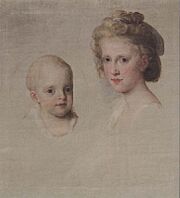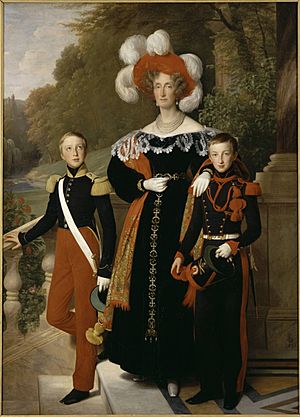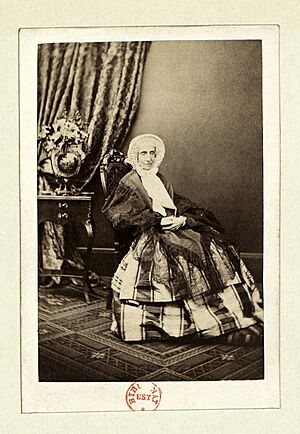Maria Amalia of Naples and Sicily facts for kids
Quick facts for kids Maria Amalia of Naples and Sicily |
|||||
|---|---|---|---|---|---|
| Duchess of Orléans | |||||
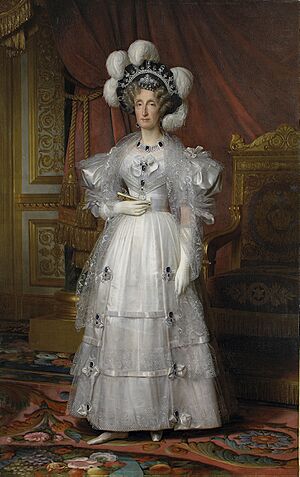
Portrait by Louis Hersent, c. 1836
|
|||||
| Queen consort of the French | |||||
| Tenure | 9 August 1830 – 24 February 1848 | ||||
| Born | 26 April 1782 Caserta Palace, Naples |
||||
| Died | 24 March 1866 (aged 83) Claremont House, Surrey, England |
||||
| Burial | Royal Chapel, Dreux, France | ||||
| Spouse | |||||
| Issue |
|
||||
|
|||||
| House | Bourbon-Two Sicilies | ||||
| Father | Ferdinand I of the Two Sicilies | ||||
| Mother | Maria Carolina of Austria | ||||
| Signature | |||||
Maria Amalia Teresa of Naples and Sicily (born April 26, 1782 – died March 24, 1866) was the last Queen of France. She became queen when she married Louis Philippe I, who was King of the French.
Some of her famous grandchildren included Leopold II of Belgium, Empress Carlota of Mexico, Ferdinand I of Bulgaria, and Queen Mercedes of Spain. Maria Amalia often wrote letters to Empress Carlota when she was in Mexico.
Contents
Growing Up in Royalty
Maria Amalia was born on April 26, 1782, at the Caserta Palace near Naples. She was one of eighteen children born to Ferdinand I of the Two Sicilies and Maria Carolina of Austria.
As a young princess, she received a Catholic education. Her mother, Maria Carolina, was very involved in her life, similar to her own mother, Maria Theresa. When Maria Amalia was a child, her mother and her aunt, Marie Antoinette, planned for her to marry her cousin, Louis Joseph, Dauphin of France. He was supposed to become the future king of France, but he sadly died in 1789.
Maria Amalia's early life was full of big changes and challenges. Her aunt, Marie Antoinette, was executed during the French Revolution. This event deeply affected Maria Amalia and her family. At first, the court in Naples was not against the revolution. However, when the French monarchy was ended and her aunt and uncle, Louis XVI, were executed, Maria Amalia's parents joined a group of countries fighting against France.
In 1798, the royal family had to escape to the Kingdom of Sicily. They left Naples on a British ship. Maria Amalia spent some time in Austria with her mother. In 1802, she returned to Naples. But in 1806, Napoleon invaded Naples, forcing the family to flee to Sicily again. They settled in Palermo, protected by British soldiers.
While in exile, Maria Amalia met Louis Philippe d'Orléans. He was also forced to leave France because of the French Revolution and Napoleon's rise to power. Louis Philippe's father had been executed during the revolution.
Maria Amalia and Louis Philippe married in 1809 in Palermo, Italy. She then became the Duchess of Orléans. Their marriage was seen as controversial by some. Maria Amalia was the niece of Marie Antoinette, while Louis Philippe was the son of a man who had supported her aunt's execution. Maria Amalia's mother was also unsure about the marriage at first. But Louis Philippe convinced her that he wanted to make up for his father's actions.
Life as Duchess of Orléans

In the early years of their marriage, Maria Amalia and Louis Philippe lived in Palermo. They stayed in a palace given to them by her father, under British protection.
In 1814, Maria Amalia moved to France with her husband. They tried to build a home for their growing family. However, when Napoleon briefly returned to power, they had to flee again. Before her husband became king, Maria Amalia and Louis Philippe often struggled with money. They had no income except what the British crown gave them. In 1817, the family was allowed to return to France.
They lived in the Palais-Royal, which had been her father-in-law's home. Even with money worries, they spent a lot to restore the palace to its former glory. The Palais-Royal became a popular place for high society in Paris. However, Louis Philippe's sister, Madame Adelaide, was often seen as the main hostess. Maria Amalia was described as dignified but quiet.
Becoming Queen of the French
In 1830, after a period of unrest called the July Revolution, Louis Philippe became King of the French. This made Maria Amalia the Queen of the July Monarchy. Maria Amalia was not happy about her husband becoming king. She reportedly called it a "catastrophe."
During the July Revolution, the Orléans family was at their country home, Neuilly. Louis Philippe's sister, Adélaïde, convinced him that it was time to lead the opposition against King Charles X. She wanted him to become the leader of a constitutional monarchy. Maria Amalia, however, was loyal to the old royal family.
When people came to Neuilly to offer Louis Philippe the crown, Maria Amalia refused. She told them that her husband was an honest man and could not take the crown. But Adélaïde accepted the offer, saying her brother would do anything to prevent chaos in France. Adélaïde's answer was accepted over Maria Amalia's. It is believed that Louis Philippe accepted the crown largely because of his sister, Adélaïde.
When Maria Amalia heard that Louis Philippe had accepted the crown, she cried. She said, "What a catastrophe! They will call my husband an usurper!" She did not want to return to Paris in a grand carriage, as it would look like a triumph. When she arrived at the Palais-Royal, people noticed she looked like she had been crying. She and her sister-in-law visited people who were hurt during the revolution and gave them money.
Maria Amalia felt that being queen brought no advantages, only the end of their peaceful family life. But she believed it was God's will, so she accepted her duty. She said, "Since by God's will this Crown of Thorns has been placed upon our heads, we must accept it and the duties it entails." She was present when Louis Philippe was declared King of the French. She was automatically given the title Queen of the French.
Maria Amalia did not get involved in politics. She tried to stay out of it. She was known for her simple lifestyle and her charity work. King Louis Philippe wanted to show that his family lived a simple, middle-class life. So, the royal court was not very fancy. This suited Maria Amalia, who already preferred a quiet life.
The Queen's daily life involved family dinners, religious duties, and helping others. She spent her time sewing with her daughters and daughters-in-law. She also worked with her secretaries, reading letters and helping poor people. Maria Amalia received a large personal allowance, and she spent most of it on charity. She gave money to those in need, no matter their political or religious beliefs. She was also the Protector of several charity groups.
She performed her royal duties with dignity. In 1843, she hosted Queen Victoria of Britain at the Château d'Eu.
Maria Amalia had accepted the crown unwillingly, but she felt it was her duty to keep it. During the French Revolution of 1848, Maria Amalia tried to convince Louis Philippe to use the army to stop the riots and protect his crown. But he did not listen to her. When a crowd marched towards the Tuileries Palace, Louis Philippe was convinced by his advisors to leave. He signed his abdication, giving up his throne for his grandson, even though Maria Amalia disagreed. As the family left the palace, Maria Amalia reportedly told a minister, "Ah Monsieur, you were not worthy of such a good king!"
The family left in a hurry. Maria Amalia reportedly fainted and had to be carried into her carriage. They were joined by some of their children and grandchildren. Their eldest son's widow and her sons stayed at the palace to fight for their grandson's right to the throne.
The family left Paris and traveled to England in different groups. Maria Amalia and Louis Philippe stayed for a while in a friend's cottage before secretly leaving France by ship for England.
Life in Exile and Passing
In England, Queen Victoria welcomed Louis Philippe and Maria Amalia. They were allowed to live at Claremont House in Surrey for the rest of their lives. They did not have money problems because the French government did not take their property.
Louis Philippe died two years later. After his death, Maria Amalia continued to live in England. She went to Mass every day and was well-known to Queen Victoria. She spent her final years living a quiet family life. Most of her children joined her in England. Maria Amalia believed that the older branch of the Bourbon family had a stronger claim to the French throne. She supported her son when he made peace with the head of that family. When she died, she asked to be called Duchess of Orléans on her grave, not Queen of the French.
Maria Amalia passed away on March 24, 1866, at the age of 83. She was the last living grandchild of Empress Maria Theresa of Austria. According to her wishes, she was buried wearing the same dress she had kept since her husband left France in 1848.
Her Children
Maria Amalia and Louis Philippe had ten children:
| Name | Picture | Born | Died | Notes |
|---|---|---|---|---|
| Ferdinand, Duke of Orléans |  |
September 3, 1810 | July 13, 1842 | Married Duchess Helene of Mecklenburg-Schwerin, and they had children. |
| Princess Louise d'Orléans | 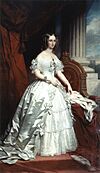 |
April 3, 1812 | October 11, 1850 | Married Leopold I of Belgium, and they had children. |
| Princess Marie d'Orléans |  |
April 12, 1813 | January 6, 1839 | Married Duke Alexander of Württemberg, and they had children. |
| Louis, Duke of Nemours | 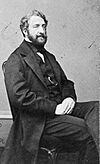 |
October 25, 1814 | June 26, 1896 | Married Princess Victoria of Saxe-Coburg and Gotha, and they had children. |
| Princess Françoise d'Orléans |  |
March 26, 1816 | May 20, 1818 | Died when she was two years old. |
| Princess Clémentine d'Orléans | 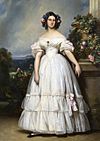 |
March 6, 1817 | February 16, 1907 | Married Prince August of Saxe-Coburg and Gotha, and they had children. |
| François, Prince of Joinville |  |
August 14, 1818 | June 16, 1900 | Married Princess Francisca of Brazil, and they had children. |
| Charles, Duke of Penthièvre |  |
January 1, 1820 | July 25, 1828 | Died when he was eight years old. |
| Henri, Duke of Aumale | 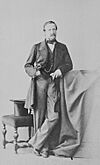 |
January 16, 1822 | May 7, 1897 | Married Princess Maria Carolina of Bourbon-Two Sicilies, and they had children. |
| Antoine, Duke of Montpensier |  |
July 31, 1824 | February 4, 1890 | Married Infanta Luisa Fernanda, Duchess of Montpensier, and they had children. |


